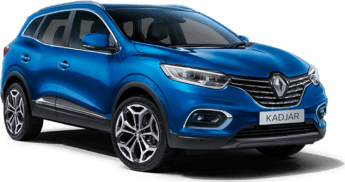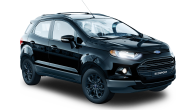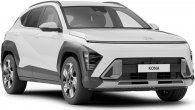Just what is a Kadjar?
Far from being an obscure French phrase for something, or the name of a seldom-spotted mystical creature, Renault tells us that ‘Kadjar’ is a blending of ‘quad’ and ‘agile’.
Translated, it’s meant to give you the idea that this SUV is capable and sporty, but we reckon its most important attribute for Australian buyers is its size.
See, the Kadjar is a big small SUV… or a small medium SUV… and it slots into Renault's line-up between the very small Captur, and the larger Koleos.
What you need to know is that it slots into a narrow gap between popular ‘medium’ SUVs like the Toyota RAV4, Mazda CX-5, Honda CR-V and Nissan X-Trail, and the smaller alternatives, like the Mitsubishi ASX, Mazda CX-3 and Toyota C-HR.
So, it sounds like the ideal middle-ground for many buyers, and wearing a Renault badge, it has some of that Euro appeal to draw folks looking for something a little different.
Renault Kadjar 2020: Life
| Engine Type | Inline 4, 1.3L |
|---|---|
| Fuel Type | Premium Unleaded Petrol |
| Fuel Efficiency | 6.3L/100km (combined) |
| Seating | 5 |
| Price From | $17,600 - $22,330 |
Does it represent good value for the price? What features does it come with?
7 / 10
The Kadjar launches in Australia in three variants, the base Life, mid-spec Zen and top-spec Intens.
It’s genuinely hard to tell each specification apart from the outside, with the biggest tell being the alloy wheels.
The entry-level Life starts from $29,990 – a smidge more than its Qashqai cousin, but justifies it with a fairly impressive set of kit from the get-go.
Included are 17-inch alloy wheels (no steelies for the Kadjar range), 7.0-inch multimedia touchscreen with Apple CarPlay and Android Auto connectivity, 7.0-inch digital dashboard with dot-matrix gauges, seven-speaker audio system, dual-zone climate control with dot-matrix displays in the dials, cloth seat trim with manual adjust, ambient cabin lighting, turn-key ignition, front and rear parking sensors with reversing camera, tyre pressure monitoring, auto rain-sensing wipers, and auto halogen headlights.
.jpg)
Stock active safety includes auto emergency braking (AEB – works only at city speed with no pedestrian or cyclist detection).
Next up in the range is the Zen. Starting from $32,990, the Zen includes all of the above, plus an upgraded cloth seat trim with additional lumbar support, leather steering wheel, push-start ignition with keyless entry, puddle lights, front and rear fog lights with front cornering function, side parking sensors (for 360-degree sensor coverage), sun visors with mirrors and lights, roof rails, one-touch folding rear seats, rear armrest with two cupholders, rear air vents, false boot floor, as well as heated and auto-folding wing mirrors.
Active safety spec is increased to include blind spot monitoring (BSM), and lane departure warning (LDW).
The top-spec Intens ($37,990) gains massive 19-inch two-tone alloy wheels (wearing Continental ContiSportContact 4 rubber), a fixed panoramic sunroof, electro-chromatic rear-vision mirrors, Bose-branded premium audio, leather seat trim with electric adjust for the driver, heated front seats, LED headlights, LED interior lights, hands-free auto parking, auto high beams, ‘Kadjar’ branded door sills, and extra chrome trim elements throughout.
.jpg)
All cars are well specified, but very close together in terms of spec and looks. Good for entry-level buyers, but perhaps not so much for Intens buyers. The only option comes in the form of an auto-dimming rear vision mirror and sunroof pack ($1000) for the mid-spec, as well as premium paints across the range ($750 – get blue, it’s the best).
It’s a shame to see the top-spec Intens missing out on a larger multimedia touchscreen to add extra pizzazz to the cabin. Our main concern is the lack of a high-speed radar safety suite, which could really lift the Kadjar up.
Price-wise it’s probably fair to assume you’ll be cross-shopping the Kadjar against other niche European-size rivals like the Skoda Karoq (from $32,990), and Peugeot 2008 (from $25,990).
Is there anything interesting about its design?
7 / 10
One of Renault’s points of difference is its design, and the Kadjar delivers with some definite Euro flair over rivals.
It has presence in real life, especially wearing the premium paints, and I’m a fan of its big, curvaceous wheelarches and well-appointed chrome trimmings.
The sculpted light fittings, front and rear, are Renault signatures, although the best effect is with the blue-tinged LEDs only available on the top-spec Intens.
.jpg)
When lined up against some of the competition you could argue the Kadjar isn’t exciting to look at, but at least it doesn’t border on controversial like Mitsubishi’s Eclipse Cross.
The Kadjar’s interior is where it really shines. It’s certainly a step above the Qashqai when it comes to trim, and has plenty of nice, well thought out touches.
The raised console and dash are finished in an array of tasteful chromes and greys, although there’s not much difference aside from the seats between each variant – again this is a good thing for base car buyers.
.jpg)
The digital dash is neat, and combined with the ambient lighting across the range makes for a more upmarket cabin ambiance than the Eclipse Cross or Qashqai, while not being quite as zany as the 2008. With a few options fitted, the Karoq perhaps gives the Renault a run for its money.
Other touches to be appreciated are the flush touchscreen and climate controls with dot-matrix displays inside the dials.
The lighting theme can be changed to whatever colour suits owners, as can the digital dash, which is available in four layouts ranging from minimalist to sporty. Annoyingly, both require intimate knowledge of several settings screens to alter.
How practical is the space inside?
8 / 10
The Kadjar is brilliantly sized if you count it as a small SUV. It has legroom, amenities and boot space that easily rival SUVs in the size bracket above.
In the front there’s a surprising amount of headroom, despite an upright driving position, and this isn’t affected by the sunroof available on the top-spec Intens.
The ease-of-use for the media screen is at least a league above its Nissan cousin, with relatively decent software. The major let-down here is the lack of a volume knob for quick adjustment on the fly.
Instead you’re made to use a touch panel running down the side of the screen. Thankfully the climate controls are comprised of a sensible tri-dial layout with cool digital displays inside them.
Oddly, there’s no larger screen available on higher grades, nor does the impressive portrait screen available on the larger Koleos.
In terms of front seat amenities there’s a massive centre console box with a split top, trenches in the doors and a large storage area underneath the climate controls which also hosts two USB ports, an aux port, and a 12-volt power outlet.
.jpg)
There are four bottle holders, two in the centre console, and two in the doors, but in typical French fashion they are small. Expect to be able to store 300ml containers or less.
The back seat is almost the star of the show. The seat trim is fantastic, at least in the top two grades we were able to sample, and I had heaps of airspace for my knees behind my own driving position.
Headroom is fantastic, and so is the presence of rear air vents, two more USB ports and a 12-volt outlet. There’s even a leather-trimmed drop down armrest with dual bottle holders, small bottle holders in the doors and rubber padded trim for your elbows.
Then there’s the boot. The Kadjar offers 408 litres (VDA) which is slightly smaller than the Qashqai (430L), much smaller than the Skoda Karoq (479L), yet bigger than the Mitsubishi Eclipse Cross (371L) and about on-par with the Peugeot 2008 (410L).
.jpg)
It’s still on-par and even bigger than some proper mid-size rivals, so a big win there.
What are the key stats for the engine and transmission?
7 / 10
The Kadjar is available with just one engine and transmission across the range in Australia.
It’s a 1.3-litre four-cylinder turbo-petrol engine, with competitive power outputs (117kW/260Nm).
This engine was developed alongside Daimler (hence, it appears in the Benz A- and B-Class ranges) but has slightly more power in Renault’s configuration.
.jpg)
The only transmission available is a seven-speed ‘EDC’ dual-clutch auto. It has familiar dual-clutch niggles at low-speeds, but is a smooth shifter once you’re on the go.
Kadjars delivered in Australia are petrol front-wheel drive only. There is a manual, diesel, all-wheel drive available in Europe, but Renault says it would have been too niche a product to offer in Australia.
How much fuel does it consume?
8 / 10
Using a dual-clutch auto and a stop-start system, Renault posts a claimed combined cycle fuel consumption figure of 6.3L/100km for all Kadjar variants available in Australia.
As our drive loops were not reflective of every-day real world driving, we won’t provide a real-world figure this time around. Stay tuned for our later week long road tests to see how we go with that.
Warranty & Safety Rating
What safety equipment is fitted? What safety rating?
7 / 10
The Kadjar enters a market where active safety has a heavy focus, so it’s a shame to see it arrive with no radar-based high-speed active safety on any variant.
Present is city-speed auto emergency braking (AEB), and the higher spec Zen and Intens gain blind-spot monitoring and lane departure warning (LDW), which makes a strange rumble-strip sound-effect when you leave your lane.
Active cruise control, pedestrian and cyclist detection, driver attention alert, traffic sign recognition are not present on the Kadjar range.
Expected safety comes in the form of six airbags, stability, traction and brake controls, as well as hill start assist.
What does it cost to own? What warranty is offered?
7 / 10
Renault launches the Kadjar alongside a refreshed “555” ownership scheme, for five years of unlimited kilometer warranty, five years of roadside assist, and five years of capped price servicing.
This has upped Renault to compete strongly with even mainstream Japanese rivals.
Kia’s Seltos is the leader in this size-bracket with its seven-year/unlimited kilometer promise.
Service pricing for the Kadjar range comes in at $399 for the first three services, $789 for the fourth (due to the replacement of spark plugs and other essential items) and then $399 for the fourth.
It’s certainly not the cheapest service plan we’ve ever seen, but it’s improved over the previous four-year service plan. All Kadjars require servicing once every 12 months or 30,000km, whichever occurs first.
The Kadjar has a timing chain and is built in Spain.
What's it like to drive?
7 / 10
Thanks to its more interesting mechanicals, the Kadjar has quite a unique small SUV drive experience.
The seating position is generally very good. You sit high in this Renault, but that leads to great visibility, at least out the front and sides.
Round the back is a slightly different story, where the design has cropped in the boot window slightly, and made for chunky C-Pillars that create slight blind spots.
We were only able to sample the mid-spec Zen and top-spec Intens, and it was honestly hard to pick between them when it came to ride. Despite the Intens’ massive wheels, road noise was very low in the cabin.
.jpg)
The ride was soft and comfortable, even more so than the Qashqai, with the Kadjar sporting supple springs.
The steering is interesting. It’s somehow even lighter than the already featherweight steering that appears in the Qashqai. This is initially a good thing, as it makes the Kadjar super easy to point around and park at lower speeds, but that lightness leads to a lack of feeling at higher speeds.
It just feels overly (electrically) assisted. There’s very little feedback making its way into your hands, and this makes it much harder to be confident in the corners.
Handling is okay, but hampered a bit by the steering and naturally high centre of gravity.
.jpg)
The engine is a peppy little unit from the get-go, with peak torque available from just 1750rpm. There’s just a smidge of turbo lag and transmission catch-up under acceleration, but the whole package is surprisingly responsive.
While the transmission seems to be smarter at speed, switching ratios quickly, the limitations of the engine becomes apparent during highway maneuvers or higher-speed twisty stuff. There’s just not a whole lot of power after that intital peak surge.
One criticism you can’t level at the Kadjar is that it’s uncomfortable. The refinement in the cabin remains excellent at speed, and with the light steering there are few characteristics that will get on your nerves, even on long drives.
Verdict
The Kadjar is an interesting entrant in the SUV world, with ideal dimensions and plenty of Euro-tinged style, cabin ambiance, and impressive multimedia to make up for its slight jump in price over some rivals.
It certainly prioritises comfort and refinement over a sporty or engaging drive, but we think it will also prove a capable city-slicker for those who spend most of their time in a capital city.
Our pick of the range is the Zen. It offers the extra safety and most important spec items at a great price.
The Intens has the most pizzazz, but a big jump in price, while the Life misses out on those extra safety bits and smart spec items.
Note: CarsGuide attended this event as a guest of the manufacturer with travel and meals provided.




.jpg)
.jpg)
.jpg)







.png)










_cropped_0.jpg)


.jpg)
.jpg)
.jpg)




Comments